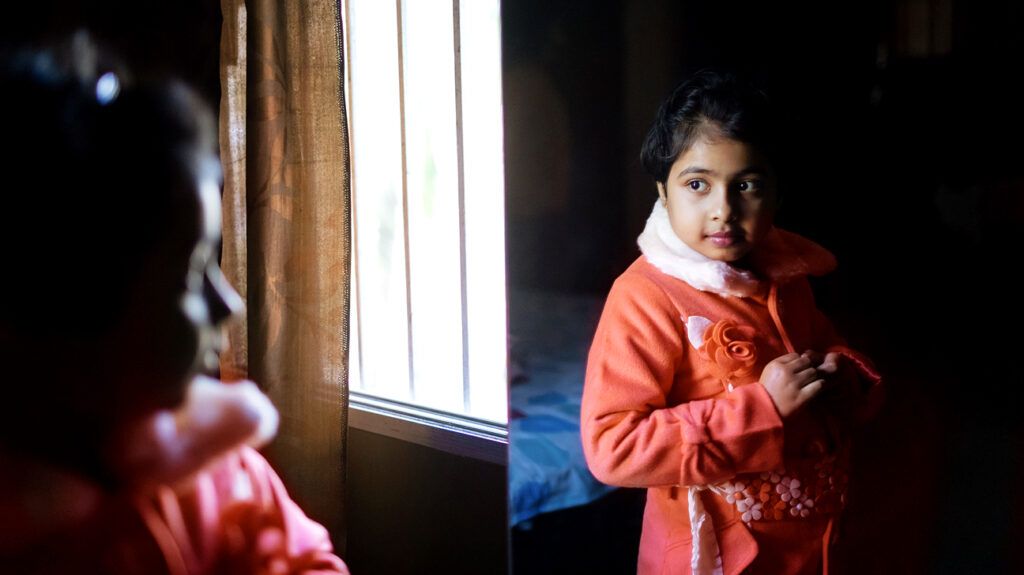Eczema is a common rash during childhood. It can happen on several areas of the body, including the face. Caregivers can help manage symptoms with creams, bathing techniques, and medications.
Individuals with eczema may experience dry, sore, and itchy skin. The skin may crack, weep with clear fluid, and then scab over.
Infants with eczema often have a rash on their face and scalp, as well as behind their ears. Toddlers, older children, and adolescents may also have eczema rash in the creases of their knees, elbows, and ankles or all over the body.
This article explains the appearance and symptoms of facial eczema, its causes and triggers, and how eczema differs by age. It also looks at how doctors diagnose and treat children’s facial eczema.

If a child has eczema on their face, they may have
- a rash on their cheeks and scalp that may appear red, brown, purple, or gray
- dry, scaly areas that may weep or ooze clear fluid
- itchy skin
- small, rough bumps
- scratch marks
- blisters that crust over
- facial skin that feels warm with some inflammation
- after healing, lighter or darker skin than before
- sleep disruption due to itching
Over time, eczema can cause thick, scaly, and tough skin that itches most of the time. Seeking early treatment can help prevent this.
Experts are unsure of the precise cause of eczema. Researchers have found that several factors may play a role in eczema, such as:
- genes
- the immune system
- things that come into contact with the skin
The outer layer of skin, known as the skin barrier, protects against things the skin may come into contact with, such as pollution, dust mites, and fragrances in lotion. It also helps keep the skin hydrated.
Gaps
- moisture to escape from the skin, resulting in dryness
- dust mites, fragrances, and other things to enter the skin barrier, causing inflammation
- bacteria and viruses to cross the protective barrier, possibly leading to infection
The location, signs, and symptoms of eczema may vary with age.
Infants
In infants, eczema typically develops before
Infants may rub against blankets or other objects when they have itchy skin. Rubbing their skin may cause tiny bumps that ooze fluid and crust over. If they rub their skin to try and relieve the itch, their skin may appear red, swollen, or raw.
The itch, rash, and dry skin that happens with eczema may cause an infant to act fussy or have difficulty sleeping.
Toddlers
Eczema also causes itchy, scaly patches on other body areas, such as the elbows, knees, and ankles. It may also appear on the hands, neck, and wrists.
Children with darker skin tones are more likely to develop eczema on their extremities than children with lighter skin tones. Some young children also have extra creases or folds underneath their lower eyelids,
Older children and teenagers
Small, itchy bumps may develop on the skin instead of a weepy rash. The bumps may be red or pink on light skin tones or gray, brown, or violet on darker skin tones.
The skin may become thick from long-term scratching and rubbing. Thickened skin generally remains extremely dry and itches most of the time. Skin beneath the eyes may also begin to look darker.
Children with dry, cracked skin are more prone to infection. If a parent or caregiver notices yellow or golden crusts on their child’s skin, they should contact a doctor for advice. These symptoms may indicate that a child has a bacterial infection.
Eczema has no cure, but most parents and caregivers can help manage their child’s facial eczema with the following strategies:
Bathing techniques
Bathing helps remove dirt and irritants from a child’s skin. When bathing a child with eczema, an individual could try:
- using lukewarm water
- using a mild, fragrance-free cleanser
- not rubbing their skin
- limiting bathing to 5–10 minutes
Moisturize
Moisturizing a child’s skin at least twice per day may relieve dryness. Apply an eczema-friendly moisturizer within a few minutes of bathing to lock in moisture.
Corticosteroids
A doctor may prescribe corticosteroids as creams, lotions, ointments, or sprays to apply to the skin. These topical medications help reduce inflammation and other symptoms, such as itching.
They may also recommend applying the corticosteroid after a bath but before applying a moisturizer.
Identify triggers
Some factors may cause a child’s eczema to flare up. It is crucial to identify these triggers and try and find ways to limit or avoid them.
Common triggers that worsen eczema may include:
- dry air
- tobacco smoke
- pet dander
- pollen
- certain fabrics
- laundry detergent
- fabric softeners
- soaps
- shampoos
- wipes
- baby powders
- sweat
- saliva
A parent or caregiver should speak with a healthcare professional if they notice their child has any of the following:
- symptoms of eczema
- sleep disruption from itching
- significant disruption to their daily activities due to their skin rash
- symptoms of a skin infection
Parents and caregivers should seek immediate medical help if it looks like their child has an infection with their eczema rash and a fever.
Eczema often starts in early childhood and develops as a red, brown, purple, or gray rash, depending on the child’s skin color. It is common for infants with eczema to have it on their cheeks, forehead, or scalp.
Eczema may present slightly differently over time. It may begin on the face and scalp in infancy, then develop on the elbows, knees, and ankles throughout toddlerhood.
A healthcare professional can help parents and caregivers find the most suitable way to manage their child’s eczema.
